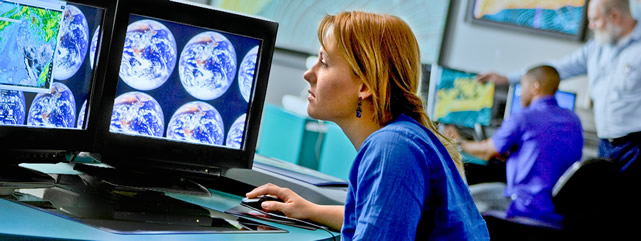Document Type
Article
Publication/Presentation Date
9-2004
Abstract/Description
This second of two papers on extratropical transition (ET) over the southwest Pacific Ocean focuses on the variability of ET. A climatology of ET onset based on a previously described objective technique shows that ET commences 158 of latitude nearer the equator on average than similar cases from the Northern Hemisphere. Characteristic midlatitude circulation patterns accompanying ET near 308S are identified by means of empirical orthogonal function (EOF) analysis of 50 storms. The first eigenvector pattern, explaining nearly half the circulation variability, expresses relaxed and enhanced pressure gradients south of the storm that define composites similar to ‘‘cradled’’ and ‘‘captured’’ classifications previously described for the southeast Indian Ocean. The second EOF distinguishes redeveloping from weakening storms. Reintensifying storms were located beneath strong cyclonic vorticity advection (CVA) near the equatorward entrance region of an upper jet whereas the upper jet was well to the west of weakening storms. A survey of factors responsible for modulating central sea level pressure change during ET was conducted for the 50 storms. The quantity most strongly correlated with surface development was found to be CVA at the jet level. Extratropical reintensification occurred when the surface cyclone was located beneath the equatorward entrance region of an upper jet for storms between 288 and 348S, and beneath the poleward exit jet region for storms farther south. Strongest examples of redevelopment each occurred beneath a potent double jet signature aloft, with maximum storm-relative upper-level CVA located directly above the surface low and net vorticity fluxes reflecting amplification of the upper wave. Weakening storms featured a weakening upper trough directly above the storm, with CVA to the east.
Publication Title
Monthly Weather Review
DOI
https://doi.org/10.1175/1520-0493(2004)132%3C2145:ETOSPT%3E2.0.CO;2
Required Publisher’s Statement
© Copyright 2004 American Meteorological Society (AMS). Permission to use figures, tables, and brief excerpts from this work in scientific and educational works is hereby granted provided that the source is acknowledged. Any use of material in this work that is determined to be “fair use” under Section 107 of the U.S. Copyright Act September 2010 Page 2 or that satisfies the conditions specified in Section 108 of the U.S. Copyright Act (17 USC §108, as revised by P.L. 94-553) does not require the AMS’s permission. Republication, systematic reproduction, posting in electronic form, such as on a web site or in a searchable database, or other uses of this material, except as exempted by the above statement, requires written permission or a license from the AMS. Additional details are provided in the AMS Copyright Policy, available on the AMS Web site located at (http://www.ametsoc.org/) or from the AMS at 617-227-2425 or copyrights@ametsoc.org.
Scholarly Commons Citation
Sinclair, M. R. (2004). Extratropical Transition of Southwest Pacific Tropical Cyclones. Part II: Midlatitude Circulation Characteristics. Monthly Weather Review, 132(9). https://doi.org/10.1175/1520-0493(2004)132%3C2145:ETOSPT%3E2.0.CO;2

